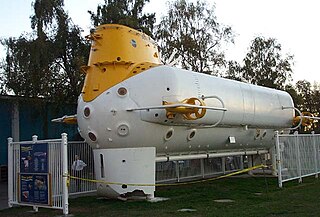 W
WThe Ben Franklin mesoscaphe, also known as the Grumman/Piccard PX-15, is a crewed underwater submersible, built in 1968. It was the brainchild of explorer and inventor Jacques Piccard. The research vessel was designed to house a six-man crew for up to 30 days of oceanographic study in the depths of the Gulf Stream. NASA became involved, seeing this as an opportunity to study the effects of long-term, continuous close confinement, a useful simulation of long space flights.
 W
WBiosphere 2 is an American Earth system science research facility located in Oracle, Arizona. Its mission is to serve as a center for research, outreach, teaching, and lifelong learning about Earth, its living systems, and its place in the universe. It is a 3.14-acre (1.27-hectare) structure originally built to be an artificial, materially closed ecological system, or vivarium. It remains the largest closed ecological system ever created.
 W
WConcordia Research Station, which opened in 2005, is a French–Italian research facility that was built 3,233 m (10,607 ft) above sea level at a location called Dome C on the Antarctic Plateau, Antarctica. It is located 1,100 km (680 mi) inland from the French research station at Dumont D'Urville, 1,100 km (680 mi) inland from Australia's Casey Station and 1,200 km (750 mi) inland from the Italian Zucchelli Station at Terra Nova Bay. Russia's Vostok Station is 560 km (350 mi) away. The Geographic South Pole is 1,670 km (1,040 mi) away. The facility is also located within Australia's claim on Antarctica, the Australian Antarctic Territory.
 W
WD-MARS is a human analog mission to the planet Mars, taking place in Makhtesh Ramon in Israel's Negev desert. D-MARS is an acronym for "Desert Mars Analog Ramon Station", and its crew are known as "Ramonauts". Ramon's geological features and aridity are similar to those of Mars. In addition, the mission takes place in the crater because of its relative abundance.
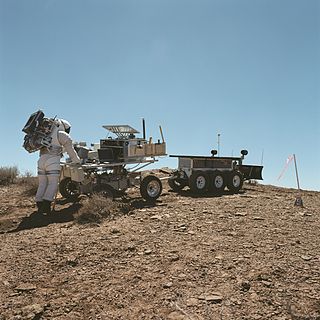 W
WNASA's Desert Research and Technology Studies is a group of teams which perform an annual series of field trials seeking to demonstrate and test candidate technologies and systems for manned exploration of the surface of the Moon, Mars, or other rocky bodies.
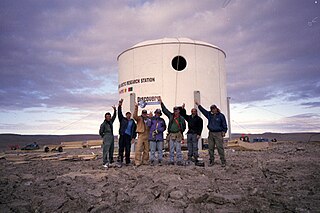 W
WThe Flashline Mars Arctic Research Station (FMARS) is the first of two simulated Mars habitats established and maintained by the Mars Society.
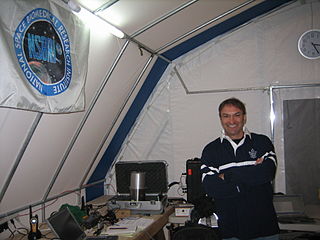 W
WThe Haughton–Mars Project (HMP) is an international interdisciplinary field research project being carried out near the Haughton impact crater on Canada's northern Devon Island. Human-centered computing (HCC) studies are aimed at determining how human explorers might live and work on other planetary objects, in particular on Mars. Conducted jointly by SETI and the Mars Institute, the project's goal is to utilize the Mars-like features of Devon Island and the impact crater to develop and test new technologies and field operating procedures, and to study the human dynamics which result from extended contact in close quarters. This knowledge will be used in planning missions by both humans and robots to other terrestrial bodies.
 W
WThe Hawaii Space Exploration Analog and Simulation (HI-SEAS) is an analog habitat for human spaceflight to Mars. HI-SEAS is located in an isolated position on the slopes of the Mauna Loa volcano on the island of Hawaii. The area has Mars-like features and an elevation of approximately 8,200 feet (2,500 m) above sea level. The first HI-SEAS study was in 2013 and NASA's Human Research Program continues to fund and sponsor follow-up studies. The missions are of extended duration from four months to a year. Its missions place HI-SEAS in the company of a small group of analogs that are capable of operating very long duration missions in isolated and confined environments, such as Mars500, Concordia, and the International Space Station.
 W
WThis is list of Mars analogs, which simulate aspects of the conditions human beings could experience during a future mission to Mars, or different aspects of Mars such as its materials or conditions. This is often used for testing aspects of spacecraft missions to that planetCrew analog experiments
 W
WThe Mars Desert Research Station (MDRS) is the largest and longest-running Mars surface simulation facility in the world, and is one of two simulated Mars analog habitats owned and operated by the Mars Society.
 W
WThe MARS-500 mission was a psychosocial isolation experiment conducted between 2007 and 2011 by Russia, the European Space Agency and China, in preparation for an unspecified future crewed spaceflight to the planet Mars. The experiment's facility was located at the Russian Academy of Sciences' Institute of Biomedical Problems (IBMP) in Moscow, Russia.
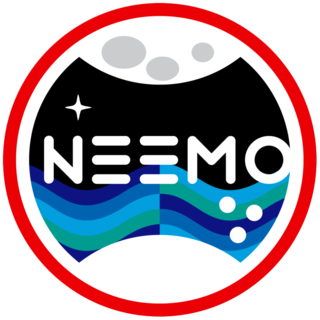 W
WNEEMO, an acronym for NASA Extreme Environment Mission Operations, is a NASA analog mission that sends groups of astronauts, engineers and scientists to live in Aquarius underwater laboratory, the world's only undersea research station, for up to three weeks at a time in preparation for future space exploration.
 W
WThe Pavilion Lake Research Project (PLRP) is an international, multi-disciplinary, science and exploration effort to explain the origin of freshwater microbialites in Pavilion Lake, British Columbia, Canada.
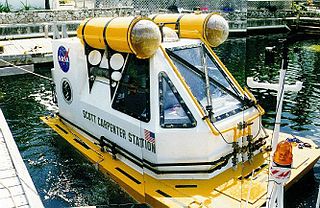 W
WThe Scott Carpenter Space Analog Station was designed by the National Aeronautics and Space Administration (NASA) as a seafloor research station—or underwater habitat. It was designed by NASA Aquanaut, Dennis Chamberland and Marine Engineer, Joseph M. Bishop and named in honor of the Mercury project astronaut and SEALAB aquanaut M. Scott Carpenter. It was used on two missions in the summer of 1997 and 1998 on the seafloor near Key Largo, Florida at the Marine Resources Development Foundation.
 W
WThe SeaOrbiter, also known as Sea Orbiter, is a proposed oceangoing research vessel. Construction was due to start in 2014 but by May 2015, only the Eye of SeaOrbiter has been completed, and as of early 2021, there is no news of any other construction.
 W
WThe Skylab Medical Experiment Altitude Test, or SMEAT, was a 56-day simulation of an American Skylab space mission from July 26–September 19, 1972 at NASA's Manned Spacecraft Center in Houston, Texas. The astronauts in the test were Bob Crippen, Karol Bobko, and William Thornton, who simulated space experiments, housekeeping and leisure activities in a hypobaric chamber. SMEAT provided a baseline for the in-orbit portion of biomedical experiments on Skylab.
 W
WThe Tektite habitat was an underwater laboratory which was the home to divers during Tektite I and II programs. The Tektite program was the first scientists-in-the-sea program sponsored nationally. The habitat capsule was placed in Great Lameshur Bay, Saint John, U.S. Virgin Islands in 1969 and again in 1970.